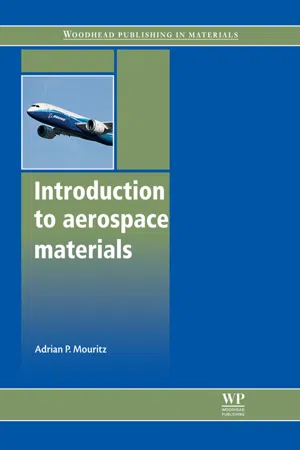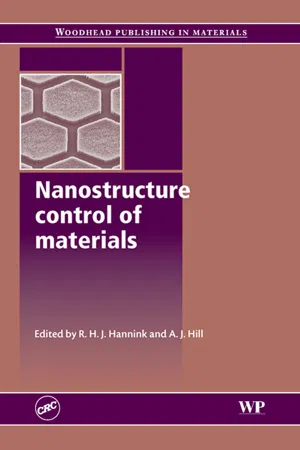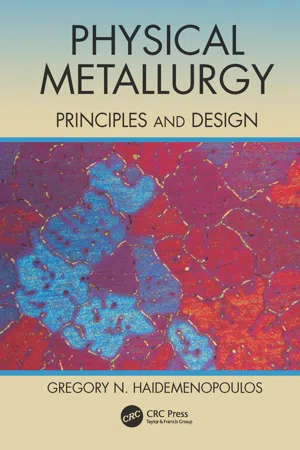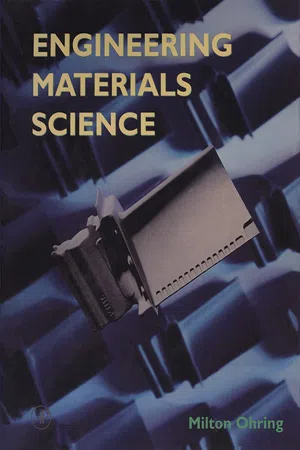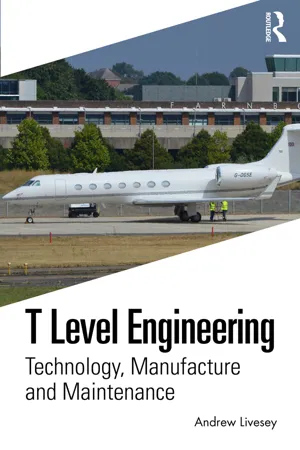Technology & Engineering
Strengthening of Metals
Strengthening of metals refers to the process of improving the mechanical properties of metals, such as hardness and toughness, to make them more suitable for specific applications. This can be achieved through various methods, including alloying, heat treatment, and cold working, which help to enhance the strength and performance of the metal without compromising its other properties.
Written by Perlego with AI-assistance
Related key terms
Related key terms
1 of 4
Related key terms
1 of 3
6 Key excerpts on "Strengthening of Metals"
- eBook - ePub
- Adrian P Mouritz(Author)
- 2012(Publication Date)
- Woodhead Publishing(Publisher)
4Strengthening of metal alloys
4.1 Introduction
Metal alloys used in aircraft structures and engines must have high mechanical properties to ensure weight-efficiency. It is essential that metals used in aircraft have sufficient strength to avoid permanent deformation and damage under the structural, aerodynamic and other loads experienced during flight. The mechanisms by which aerospace metals achieve their high strength are complex. Various mechanisms occur at the atomic, nanometre, microstructural and millimetre scales and these control the strength properties, as shown in Fig. 4.1 for the aluminium alloys used in an aircraft wing. Without these strengthening mechanisms occurring at different length scales, metals would be too soft and susceptible to plastic deformation to use in highly loaded structures and engine components. The mechanisms, when used in combination, provide aerospace engineers with weight-efficient metals with the capacity to withstand the extremely high loads experienced by modern aircraft.The strength properties of aerospace metals, which include proof strength, ultimate strength, fatigue strength and creep strength, are controlled by a multitude of factors. The main factors are:4.1 Strengthening processes used to maximise the strength of aluminium alloys in aircraft wings.- • alloy composition;
- • arrangement and bonding of the atoms;
- • type, size and concentration of precipitates and second-phase particles;
- • types and concentration of imperfections and defects;
- • metal casting processes, forming techniques and manufacturing methods.
This chapter describes the main factors that control the strength properties of metal alloys. The chapter explains the fundamental engineering science behind the development of high-strength metals for use in weight-efficient aircraft structural components. To understand the Strengthening of Metals, it is necessary to have a basic understanding of the arrangement of atoms in metals. A brief description of the crystal structures of the metals used in aircraft is provided. Following this is an overview of the various imperfections in the crystal structure which affect the strength of metals. The mechanisms by which these imperfections increase the strength of metals are outlined. The Strengthening of Metals by dislocations is explained. Dislocations are central to all the main strengthening mechanisms in metals, and what they are and how they increase strength is described. The Strengthening of Metals by precipitation hardening, intermetallic compounds, and control of the grain structure is explained. The information in this chapter provides a basic understanding of the various ways that aerospace engineers can increase the strength of metal alloys for structural applications. - eBook - ePub
- R H J Hannink, A J Hill(Authors)
- 2006(Publication Date)
- Woodhead Publishing(Publisher)
bulk materials on a nanoscale. Such materials may display enhanced mechanical, physical or chemical properties, and hence nanoengineering is of paramount importance to the evolution of new metallic materials. Rather than dealing with milligrams or grams of material, tonnes of materials are processed, at prices that are economical and sustainable for modern manufacturing.In this chapter, the principles underlying the nanoengineering of metallic materials are first considered in terms of those criteria that have the most significant effect on the mechanical properties of metals and alloys namely, the effect of grain size and the role of obstacles that retard deformation by the process of crystallographic slip. Relationships between processing, microstructure, properties and cost are discussed, followed by an introduction to manufacturing routes used in the processing of metallic materials. Four examples are then described in which microstructures are manipulated on the nanoscale in order to improve properties. These examples are concerned with the precipitation strengthening of aluminium alloys, the development of high strength low alloy steels, mechanical alloying, and rapid solidification processing.9.2 Nanoengineering of metallic materials
Traditional metallurgy has been involved with mineral-bearing ores being mined, refined, and processed into metals that are used in day-to-day living. The metals are melted, alloyed with other elements, cast, and often fabricated into wrought products by hot and cold working methods such as rolling, extrusion or forging. It is during these various processes that changes to the microstructure of the metals and alloys occur that are often on a nanoscale.In metals and alloys, improved strength is commonly achieved through control of grain size and shape, and by introducing into the grains themselves obstacles that restrict the movement of defects (dislocations) that are both generated and propagated during plastic deformation. In a practical sense, it is the yielding behaviour of metals and alloys that is a major design criterion and, because of this, special attention is paid to characterising material performance using the stress–strain curve.1 - eBook - ePub
Physical Metallurgy
Principles and Design
- Gregory N. Haidemenopoulos(Author)
- 2018(Publication Date)
- CRC Press(Publisher)
8Strengthening mechanisms
8.1 Introduction
Pure metals are soft materials. For most engineering applications they cannot provide the required strength. This is the reason alloys were invented. The strength of metals can be increased by alloying and by certain thermal, mechanical or thermomechanical processing. In the previous chapter we have seen that the plastic deformation of metals proceeds by the glide of dislocations, a process we called slip. Strengthening can be achieved by creating obstacles to dislocation glide. It is these obstacles that are created with the alloying and suitable processing discussed above. The strengthening mechanisms, which is the subject of the present chapter, are simply mechanisms of interaction between dislocations and various obstacles. The major mechanisms are: lattice resistance, strain hardening, solid solution strengthening, grain boundary strengthening and precipitation strengthening. In lattice resistance, the main obstacle to dislocation glide is the crystal lattice, the atomic bonds in particular. In strain hardening the main obstacle impeding dislocation glide is other dislocations. The interaction between dislocations forms sessile dislocations, which cannot contribute to plastic deformation. Strain hardening has been discussed in detail in the previous chapter and will not be considered further. In solid solution strengthening the obstacles are solute atoms, either substitutional or interstitial, the strain field of which interacts with dislocations. In grain boundary strengthening, the obstacles are high-angle grain boundaries, but also sub-boundaries and interfaces as the interfaces between ferrite and cementite in pearlite or the interfaces between martensite laths. Finally, in precipitation strengthening, the obstacles are precipitates, second-phase particles or intermetallic compounds formed during thermal processing. In most alloys the yield strength is the result of a superposition of strengthening mechanisms. The effectiveness of each mechanism is characterized by the specific obstacle strength, which is related to the stress required to overcome the obstacles at T = 0K - eBook - ePub
- Milton Ohring(Author)
- 1995(Publication Date)
- Academic Press(Publisher)
Fig. 9-20 . Interestingly, the ductile–brittle transition temperature also significantly drops through grain refinement, again in a Hall–Petch-like manner.FIGURE 9-20 Dependence of yield strength, fracture strength, strain to fracture (all at −196 K), and transition temperature of a low-carbon steel as a function of grain size. ×, Fracture stress; , yield stress; ◻, strain to fracture; •, transition temperature.Composite data drawn from Relation of Properties to Microstructure , American Society for Metals, Metals Park, OH (1954), and N.J. Petch, Fracture , Technology Press, MIT, Cambridge, MA and Wiley, New York, (1959).Achieving a fine and uniform grain size is usually a goal of primary processing operations, for example, casting, rolling, and annealing. Once a component is shaped, however, it is much easier to increase the grain size than to reduce it. The only way to accomplish the latter is through special solid-state phase transformations, for example, quenching and tempering of steel.9.5 STRENGTHENING NONFERROUS METALS
9.5.1 Solid Solution Strengthening
Cold working and grain size reduction have been the only ways introduced thus far for strengthening both pure and alloyed nonferrous metals. Another method applicable to all metals is to simply dissolve other alloying elements in them. Because solute and solvent atoms differ in size and electronic character, local interactions with dislocation cores are inevitable. The size mismatch (Δa/a ), defined as the ratio of the difference in the two atomic radii to the radius of the solvent atom, creates a strain whose stress field makes it harder for dislocations to move. Matrix lattice parameters change with alloying and so Δa/a is a function of solute concentration, C. It is found that alloying raises the yield stress relative to that of a pure metal by an amount proportional to ∼(Δa/a )3/2 C - eBook - ePub
Materials Selection for Design and Manufacturing
Theory and Practice
- Joseph Datsko(Author)
- 2020(Publication Date)
- CRC Press(Publisher)
Chapter 6 THERMAL STRENGTHENING AND COSTS INTRODUCTION This chapter presents detailed information and examples to enable the reader to select or specify a material on the basis of its strength after heat treating. Cost information is given so that one can determine the cost-effectiveness of a material and select the lowest cost material on the basis of mechanical strength. Since the ferrous metals are the materials most commonly used in manufacturing, and since their microstructures are more completely understood, they are emphasized. Cost and mechanical property data are included for several non-ferrous metal alloy systems and for the common plastics so that one can compare their cost effectiveness to ferrous metals. FERROUS METALS Table 6-1 lists the mechanical properties of all of the microconstituents that are associated with steel, both plain carbon and alloy. These values do not apply to any of the stainless steels or cast irons. The microstructures that result from a given thermal treatment can be predicted by means of the equilibrium and non-equilibrium diagrams discussed in the previous chapters. The following section describes a procedure for predicting the hardness, and thus indirectly the microstructure, of a heat-treated steel on the basis of its chemical composition. Table 6-1 Mechanical Properties of Ferrous Microconstituents (Microconstituents vs. cooling rate are for carbon steel) Micro-constituent Cooling rate(°F/sec) S u 2 σ o H b 1 ksi Mpa ksi Mpa ε u ε f Izod. ft-lb. α any 80 40 275 77 534 0.30 1.60 100 Ps 0.01 180 90 620 130 902 0.12 0.80 10 Pc 0.05 240 120 1655 167 1151 0.10 0.50 5 Pm 1 280 140 1930 195 1343 0.10 0.40 5 Pf 30 380 190 2620 252 1737 0.08 0.40 10 M 300–500 300–800 _ 3 _ 3 _ 3 _ 3 _ 3 0–0.1 15 Mt 180–700 _ 3 _ 3 _ 3 _ 3 _ 3. 0–1.2 180 B 300–800 _ 3 _ 3 _ 3 _ 3 _ 3 θ 4 800–1800 _ 3 _ 3 _ 3 _ 3 0 0 1 3000 kg load and 10 mm dia - eBook - ePub
T Level Engineering
Technology, Manufacture and Maintenance
- Andrew Livesey(Author)
- 2023(Publication Date)
- Routledge(Publisher)
Extrusion – shaping components by forcing the metal through a shaped hole. One way to explain this is to think about piping icing on to a cake. When you squeeze the icing bag it comes out through a shaped end with a profile.- Hydroformed – malleable metals such as aluminium can be formed into fairly complex shapes by hydroforming. This practice is extensively used on large-diameter shaped frame tubes, such as those typically used on MTB bicycles. The basic tube is put into a die assembly and then a liquid, either water-based or oil-based, is fed under pressure into the tube, forcing it outwards into the shape of the die.
- Mar-aging steel, also written maraging steel without the hyphen. This word is a combination of martensitic and aging. It is a process of adding toughness and strength to low-carbon ultra-high strength steels by heating to a high temperature for several hours before cooling. Ultra-high-strength steels get their strength from intermetallic compounds, not added carbon. The compounds may include: cobalt, molybdenum, titanium and niobium.
- Stainless precipitation hardening steel – these are low-carbon steels which have fairly high percentages of manganese, chromium, nickel, copper and titanium. The non-ferrous metals precipitate to make the steel hard. Precipitation means falling, a word that weather forecasters use for raining. In this case it is the even distribution of these compounds of non-ferrous metals in the steel, like rain drops, that make the steel hard.
- Cold worked – means steel which is rolled out when it is cold. This changes the grain structure and so makes the metal harder and stronger; but reduces ductility.
- Seamless – tubing made from billet; not rolled and seam welded.
- Air-hardening steel – this is fairly high carbon, 0.5–2%, with the addition of molybdenum, chromium and manganese. It is hardened by heating to between about 800 and 900°C then cooling in air. The heating may be carried out in a vacuum furnace.
- Butting
Index pages curate the most relevant extracts from our library of academic textbooks. They’ve been created using an in-house natural language model (NLM), each adding context and meaning to key research topics.
Explore more topic indexes
Explore more topic indexes
1 of 6
Explore more topic indexes
1 of 4
